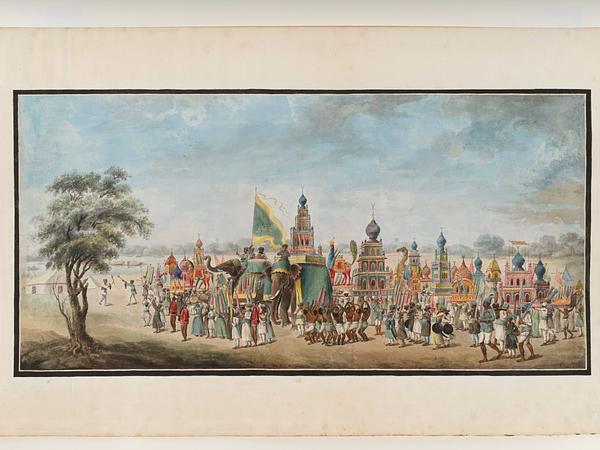In the second half of the eighteenth century, Indian artists began to paint European-style naturalistic paintings commissioned by resident Westerners. The buyers were primarily employees of the English East India Company, causing the genre to become known as ‘Company paintings’. These paintings helped map out the Indian subcontinent for their audiences, depicting a range of subjects that include Indian landscapes and architecture, local flora and fauna (
38/2008 and
110/2016) as well as the many different population groups (e.g.
61/2007,
1/2012 and
2/2012).
The subject of this watercolour is a procession in memory of the Shiite Imam Husayn, who was killed during the Battle of Kerbala in the year 680. The battle took place in Muharram, the first month of the Islamic calendar, and every year Husayn’s martyrdom continues to be commemorated by Shiites around the world during this month, for example with processions and ritual plays.
In keeping with Indian custom, the Muharram procession shown here is centred around a group of colourful model buildings (
taziya) made of paper and bamboo, representing Husayn’s mausoleum. Models of horses, camels and a Buraq figure are also part of the procession. The parade is flanked by groups of men carrying standards and weapons, as well as a group of dancing flagellants in loincloths and shackles. In the foremost part of the procession are three Indian soldiers (
sepoy) wearing the red uniform jackets of the East India Company. The assembly is headed towards a river, as Indian Muharram processions traditionally end with the ‘mausoleums’ being immersed in water.
The watercolour is from an album of Company paintings owned by Louisa Parlby (d. 1808), whose husband, James Templer Parlby, was an engineer in the service of the East India Company in Murshidabad in north-eastern India from c. 1785 to 1826.
[1] A nearly identical watercolour can be found today at the V&A Museum in London.
[2]


